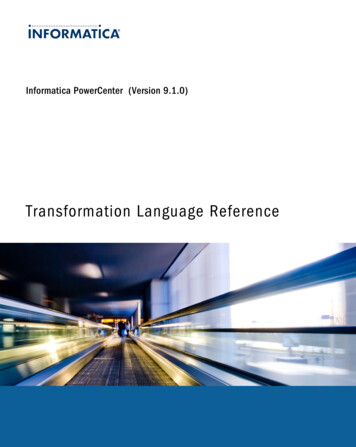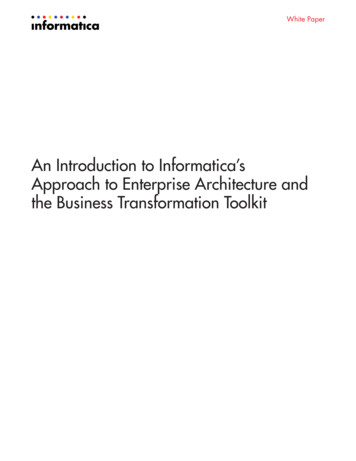
Transcription
White PaperAn Introduction to Informatica’sApproach to Enterprise Architecture andthe Business Transformation Toolkit
This document contains Confidential, Proprietary and Trade Secret Information (“ConfidentialInformation”) of Informatica Corporation and may not be copied, distributed, duplicated, or otherwisereproduced in any manner without the prior written consent of Informatica.While every attempt has been made to ensure that the information in this document is accurate andcomplete, some typographical errors or technical inaccuracies may exist. Informatica does not acceptresponsibility for any kind of loss resulting from the use of information contained in this document.The information contained in this document is subject to change without notice.The incorporation of the product attributes discussed in these materials into any release or upgrade ofany Informatica software product—as well as the timing of any such release or upgrade—is at the solediscretion of Informatica.Protected by one or more of the following U.S. Patents: 6,032,158; 5,794,246; 6,014,670;6,339,775; 6,044,374; 6,208,990; 6,208,990; 6,850,947; 6,895,471; or by the followingpending U.S. Patents: 09/644,280; 10/966,046; 10/727,700.This edition published December 2014
White PaperTable of ContentsAbstract . . . . . . . . . . . . . . . . . . . . . . . . . . . . . . . . . . . . . . . . . . . . . . . 2Introduction . . . . . . . . . . . . . . . . . . . . . . . . . . . . . . . . . . . . . . . . . . . . 2Value . . . . . . . . . . . . . . . . . . . . . . . . . . . . . . . . . . . . . . . . . . . . . . . . . 2Approach . . . . . . . . . . . . . . . . . . . . . . . . . . . . . . . . . . . . . . . . . . . . . . 3Service Orientation . . . . . . . . . . . . . . . . . . . . . . . . . . . . . . . . . . . . . . . 4The BOST Framework . . . . . . . . . . . . . . . . . . . . . . . . . . . . . . . . . . . . . . . . . . . . 4Integrated Program Planning . . . . . . . . . . . . . . . . . . . . . . . . . . . . . . . . . . . . . . 4Reference Models . . . . . . . . . . . . . . . . . . . . . . . . . . . . . . . . . . . . . . . . . . . . . . 5Shareable Repository . . . . . . . . . . . . . . . . . . . . . . . . . . . . . . . . . . . . . . . . . . . . 6Role of the Enterprise Architecture Team . . . . . . . . . . . . . . . . . . . . . . . 7Expectations from Informatica’s Business Transformation Toolkit . . . . . 8Related Documents . . . . . . . . . . . . . . . . . . . . . . . . . . . . . . . . . . . . . . . 9An Introduction to Informatica’s Approach to Enterprise Architecture and the Business Transformation Toolkit1
AbstractThis white paper introduces the Informatica Business Transformation Toolkit, a formalized framework, bestpractices, and modeling tools for private sector businesses and public sector institutions. The paper providesan overview of the philosophy, framework, methods, and tools.The Business Transformation Toolkit has been in development since 1992 through the efforts of Art Caston,one of early pioneers and global leaders in Enterprise Architecture. Informatica has leveraged over twodecades of lessons learned through real-world customer experiences to continue to enhance and expand theEnterprise Architecture practice and achieve compelling business results.Business Transformation Services from Informatica Professional Services offers comprehensive model-basedIntegrated Program Planning. The services support business and IT planners in client organizations to identifystrategic opportunities for business transformation, to define agile solutions for those opportunities, and to thenestablish and govern transformational programs that deliver real business results.Informatica uses a unique framework of industry specific Reference Models and elements to deliver complexenterprise planning initiatives. This capability is transferred to clients through the Informatica BusinessTransformation Toolkit for those clients wishing to adopt the approach as a standard Enterprise Planningcapability for future programs.IntroductionEnterprise Architecture is a capability for using model-based planning techniques to simplify and focuscomplex decision-making for strategic investments involving significant business change or transformation.Enterprise Architecture delivers opportunity assessments, target architectures, and migration strategies togovern enterprise transformation programs. Business processes use and retain secure & trusted data reducinglabor and regulatory cost of non-compliance through data governance.ValueHow does an enterprise prepare to react to changing and unpredictable market and economic conditions,new product opportunities, new channel opportunities, collaborating, merger and acquisition opportunities,systems and technology opportunities?The Business Transformation Toolkit identifies and defines enterprise capabilities. These capabilities aremodularized as reconfigurable and scalable business services. These enterprise capabilities are independentof organizational silos and politics, which provide strategists, architects, and planners the means to drive forhigh performance across the enterprise, regardless of the shifting set of strategic business drivers.The Business Transformation Toolkit has a robust Metamodel for the Business View Models of the Enterprise.This Metamodel provides a comprehensive framework in support of Strategy Development.The Business Transformation Toolkit facilitates building and implementing new or improved capabilities,adjusting business volumes, and integrating with new partners or acquisitions through common views of thesebuilding blocks and through reusing solution components. In other words, Better, Faster, Cheaper projects.2
ApproachThere are two traditional approaches to Enterprise Architecture planning as outlined in below:Figure 1. Two Enterprise Architecture Schools of ThoughtThe Business Transformation Toolkit uses a business-driven approach, which involves a rigorous andsystematic understanding of the business, modeling target state operations capabilities, and driving changes insystems and technology to achieve the desired outcomes. This same approach can be used for IT-led initiativessuch as a systems portfolio rationalization, but nonetheless it starts from a clear understanding of the businessimpacts that come from simplifying and modernizing applications systems across the enterprise.The Business Transformation Toolkit consists of four key components that embody the approach: The BOST Framework provides different views of the enterprise through models, elements, and associatedrelationships built around an underlying Metamodel; The Integrated Program Planning capability supports the development of reference and target architecturemodels, assessment of baseline capabilities, identification of transformation opportunities, and creation ofmigration roadmaps; Reusable Reference Models accelerates Enterprise Architecture initiatives by providing an evolving set ofgeneric and industry-specific models that identify essential capabilities and relationships that are crucial tovalue generation; and A flexible multi-user Modeling Tool and Repository captures the BOST Framework; stores associatedelement attributes; performs matrix analyses; and generates Web and document-based deliverables.An Introduction to Informatica’s Approach to Enterprise Architecture and the Business Transformation Toolkit3
Service OrientationThe service-based orientation applied throughout the BOST Framework is the basis for creating enterpriseagility. A majority of the required services are preplanned and managed as modular capabilities. Thesecapabilities can then be assessed based on services provided and service delivery performance. New orchanging requirements or shifts in demand are traceable to the affected capabilities.The BOST FrameworkB. The Business View caters to the strategists and planners involved in assessing market opportunities,expanding product portfolios, and leveraging partnering opportunities.O. The Operations View describes the essential functions of the enterprise and is used to design effectivebusiness processes and well-defined organizational accountabilities.S.The Systems View defines how information management applications are linked to automate businessprocess workflow and transaction management.T.The Technology View contains the architecture models that are used to design the underlying informationtechnology infrastructure, including user devices that access these applications, the computers that run theapplications, and the networks that connect it all together.Figure 2. The BOST FrameworkIntegrated Program PlanningIntegrated Program Planning is a capability targeted at large or complex enterprise initiatives. This capabilitycompliments the traditional Solution Implementation approach which is appropriate for single departmentinitiatives with clearly defined boundaries and a well-defined ROI. Both the Integrated Program Planningcapability and the Solution Implementation approach may be used in the same enterprise; the former forenterprise transformation initiatives and later for targeted solutions.4
Figure 3: Example Integrated Program Planning for an Enterprise Data Governance ProgramReference ModelsThe Business Transformation Toolkit uses Reference Modeling as the starting point for Enterprise Architecture.Reference Models are generic representations of capabilities. The components in these Reference Modelsprovide taxonomy for all related enterprise architecture steps. Regardless of how often a capability is usedor exists across the enterprise, it is represented once and only once within the reference model. ReferenceModels show linkages and inter-relationships within and across models. For example the Service FunctionModels in the Operations View are linked to the Information Models in the Operations View through therepresentation of create and use relationships. Finally, these relationships identify Systems Families in theSystems View.An Introduction to Informatica’s Approach to Enterprise Architecture and the Business Transformation Toolkit5
Figure 4: Example Retail Industry Service Function ModelShareable RepositoryThe Business Transformation Toolkit is a flexible modeling tool and repository that contains all of the modelsand components represented in the BOST Framework. The tool and repository are the mechanisms used toconvey the reusable Reference Models.Figure 5: Conceptual Model6
Role of the Enterprise Architecture TeamThis Enterprise Architecture team requires that the production of architectural deliverables and resultinggovernance processes have a single point of coordination and accountability.The typical Enterprise Architecture Core Team consists of an overall manager who also can perform the role ofMaster Architect who oversees the change program to adopt framework and staff and manage the EnterpriseArchitecture Team.The initial Enterprise Architecture team size may range from 6 to 10 key people. As the organization’suse of enterprise architecture expands, so does the need for delegating accountability for the creation andmanagement of specific capability area diagrams. This usually results in the enterprise architecture team togrow to as many as 30 to 50 people in larger organizations with a more mature EA practice.A number of these additional staff are SME’s that will be involved in the development and review of EnterpriseArchitecture deliverables, but they are usually drawn from existing Business and IS/IT organizations that maybe dispersed throughout the enterprise.The Lead Business Architect takes ownership of the Business View and provides guidance and leadership tothe Capability Area Architects. The Capability Area Architects are responsible for the Operations and SystemsArchitectures for their assigned Capability Areas. They will in turn form small teams to assist in producing thevarious deliverables at the different stages of a program as well as establish review teams for participationin workshops and walk-throughs. This capability area approach works very well in combining the operationsneeds and opportunities with the corresponding system capabilities and opportunities, bringing the systemscommunity into operations planning and vice versa.The Lead System Architect supports the Capability Area Architects in development of Target SystemsArchitectures, and, in particular, the use of Integration Systems. This role also includes integrating commonsystem requirements for Technology environments and middleware for resolution with the Lead TechnologyArchitect.The Lead Technology Architect is responsible for the Technology View deliverables. The developmentof Technology Service and Device standards is usually done in conjunction with SMEs drawn from the ITorganization for the different technology areas.The Enterprise Architecture Methodologist becomes the in-house expert on the team, understanding theFramework, Models and Methods and how to use the advanced features of the Toolkit to produce customreports, web publishing, matrices and queries.The Systems Administrator is responsible for managing the Toolkit’s Operations environment. This includesassigning User IDs and Passwords, overseeing back-up procedures and regular report or web generationactivities as well as resolving or reporting any operations problems or issues. This role also includes providingmaintenance of the contents of the diagrams, items and attributes in support of the Capability Area Architectsand other users to ensure consistency and quality of models.An Introduction to Informatica’s Approach to Enterprise Architecture and the Business Transformation Toolkit7
Expectations from Informatica’s Business Transformation ToolkitAn organization’s Enterprise Architecture practice affects everyone who is involved in assessing, planning,and designing business transformation opportunities and solutions which no longer limited to the ITorganization. There are three areas of contribution: Service delivery, program governance, and businessalignment represent increasing levels of maturity and capability of an organization’s Enterprise Architecturepractice.There are three ways in which the Business Transformation Toolkit contributes to the goals of seniormanagement and the Enterprise Architecture practice.1. By improving the Service Delivery of the IT function througha. Mapping IT resources and the functions they perform;b. Rationalizing those IT resource, addressing problem areas; andc. Establishing a service orientation to IT delivery.2. By providing more effective governance of IS and IT programs througha. Ensuring that all programs are identified and scoped as to the capability areas;b. Establishing baseline and target architectures for all impacted areas for all programs;c. Determining the appropriate migration strategies; andd. Conducting compliance reviews and consultation at critical program development stages.3. By aligning IS and IT programs with changing strategic needs of the business througha. Capturing changing business requirements and related strategies;b. Defining high-level requirements and using the business and operations models to identify and prioritizethe functions;c. Creating related target architectures, migrating strategies, roadmaps, and business cases.8
Related DocumentsAn Introduction to the BOST Framework and Reference ModelsThis white paper introduces the BOST Framework and generic and industry-specificReference Models; two components of the Informatica Business Transformation Toolkit.An Introduction to Integrated Program PlanningThis white paper introduces the Integrated Program Planning capability, a component of theInformatica Business Transformation Toolkit. It describes how to use the BOST Frameworkand Reference Models as a capability-based planning approach for either a specifictransformation opportunity or in the context of an ongoing Enterprise Architecture program.About InformaticaInformatica Corporation(Nasdaq:INFA) is the world’snumber one independent providerof data integration software.Organizations around the worldrely on Informatica to realizetheir information potential anddrive top business imperatives.Informatica Vibe, the industry’s firstand only embeddable virtual datamachine (VDM), powers the unique“Map Once. Deploy Anywhere.”capabilities of the InformaticaPlatform. Worldwide, over 5,000enterprises depend on Informaticato fully leverage their informationassets from devices to mobileto social to big data residingon-premise, in the Cloud andacross social networks. For moreinformation, call 1 650-385-5000(1-800-653-3871 in the U.S.), orvisit www.informatica.com.Learn MoreDo It Right the First TimeContact Informatica ProfessionalServices at ips@informatica.comAn Introduction to Informatica’s Approach to Enterprise Architecture and the Business Transformation Toolkit9
Worldwide Headquarters, 2100 Seaport Blvd, Redwood City, CA 94063, USA Phone: 650.385.5000 Fax: 650.385.5500Toll-free in the US: 1.800.653.3871 informatica.com linkedin.com/company/informatica twitter.com/InformaticaCorp 2013 Informatica Corporation. All rights reserved. Informatica and Put potential to work are trademarks or registered trademarks of InformaticaCorporation in the United States and in jurisdictions throughout the world. All other company and product names may be trade names or trademarks.2760 (12/02/2014)
Architecture Team. The initial Enterprise Architecture team size may range from 6 to 10 key people. As the organization's use of enterprise architecture expands, so does the need for delegating accountability for the creation and management of specific capability area diagrams. This usually results in the enterprise architecture team to
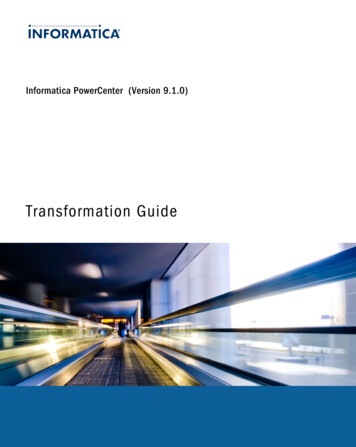
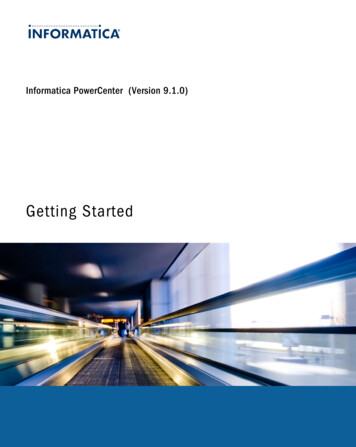

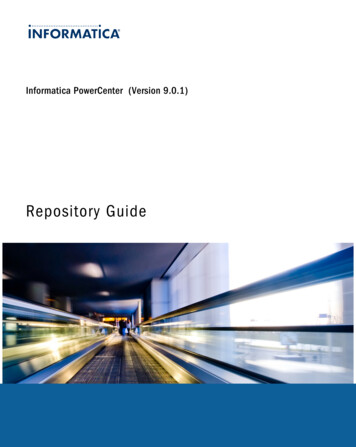
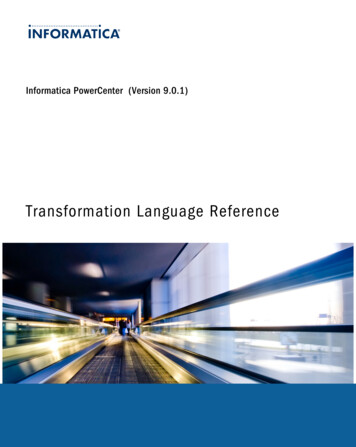
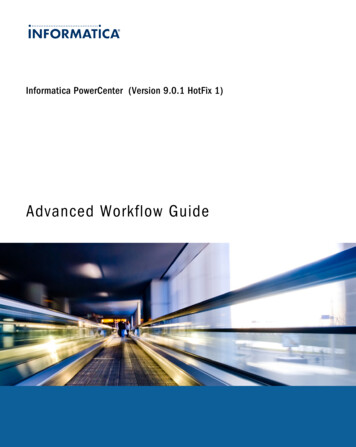
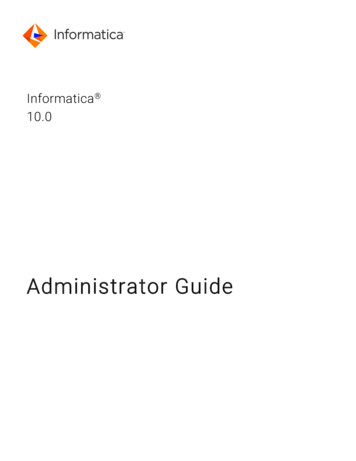
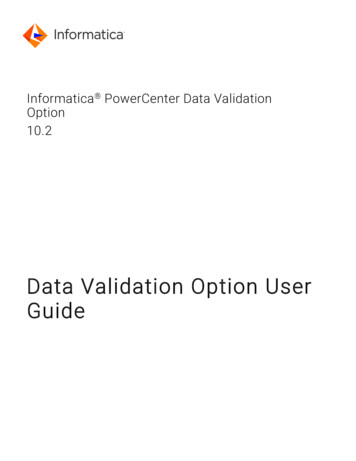
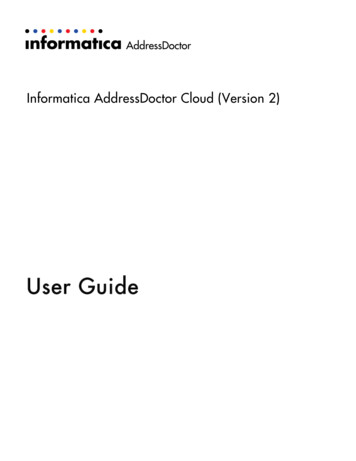
![Informatica Interview Questions and Answers [Scenario-Based]](/img/2/informatica-interview-questions-and-answers-scenario-based-1.jpg)

